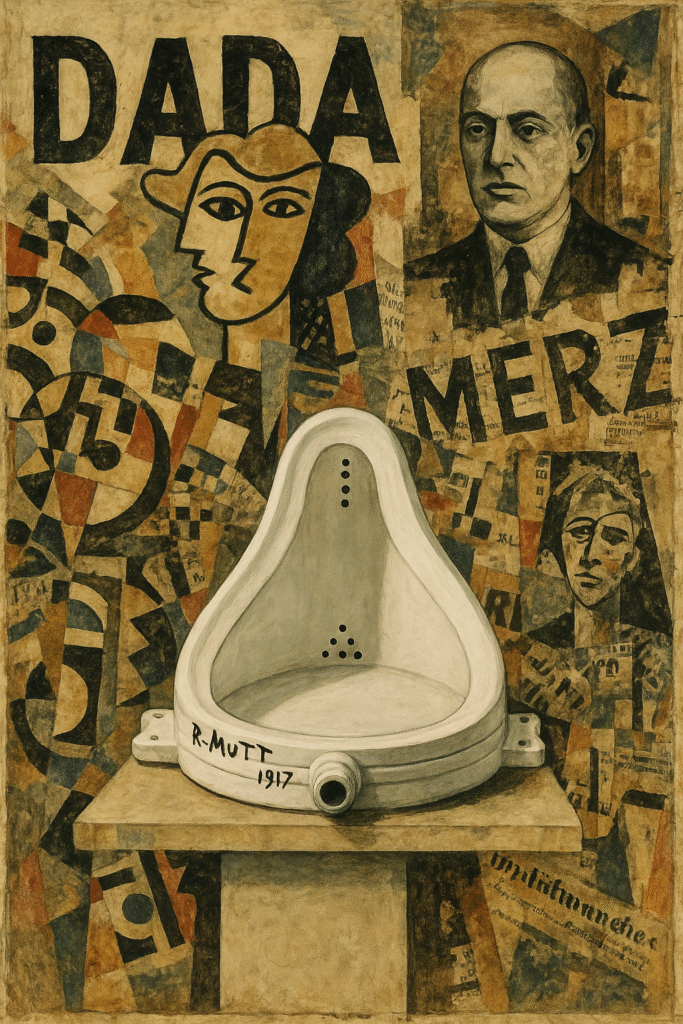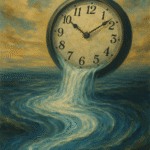The world of art experienced a profound upheaval in the early twentieth century with the advent of Dadaism, a movement as perplexing as it was revolutionary. Born from the ashes of a war-torn world, Dadaism defied conventional artistic norms and embraced an absurdism that continues to influence contemporary art forms.
Origins of Dadaism: The Anti-Art Revolt After WWI
The catalyst for the Dada movement was the immense disillusionment following World War I. Artists and intellectuals, disenchanted by the sheer futility and horror of the war, sought to break free from the shackles of traditional aesthetic values. This desire for rebellion and innovation found a home in the artistic circles of Zurich. Dadaism represented a rebellion against the established art norms and a vehement protest against the cultural and political elites.
Among the founding figures were Tristan Tzara, Hugo Ball, and Marcel Janco, who set out to dismantle the notions of what art should be. They were soon joined by other avant-garde visionaries like Hans Arp and Francis Picabia. The collective energy of these artists gave birth to absurd and nonsensical works that challenged accepted perceptions of art and beauty, ultimately questioning the very fabric of artistic expression.
Duchamp’s Fountain: Deconstructing Dada’s Absurdist Icon
One of the most iconic exemplars of Dada’s radical approach is Marcel Duchamp’s “Fountain.” This provocative work, presenting an upturned urinal signed “R. Mutt,” sparked a fierce debate regarding the definition of art itself. Duchamp’s decision to submit the piece to the Society of Independent Artists in 1917 was a deliberate move to test the boundaries of artistic acceptance.
The “Fountain” redefined the landscape of modern and conceptual art by asserting that art could be anything an artist deemed worthy of appreciation. Duchamp’s radical rethinking of art’s role and purpose pioneered new directions for future artists, who began to see potential in ordinary objects and everyday experiences.
The initial reaction to the urinal was mixed, with many in the art community and public condemning it as a vulgar affront to aesthetic values. Yet, over time, this controversial piece became a celebrated icon of modern art, epitomizing the power of conceptual thought over mere visual appeal.
Dada’s Rebellion: Embracing Chaos and Spontaneity in Art
Dadaists were primarily driven by a rejection of the logic and reason that they believed had contributed to the war’s catastrophic consequences. Embracing the absurd, they delivered art infused with shock value aimed at upending societal and artistic expectations. The shock waves of works like Hannah Höch’s photomontages exemplified Dada’s penchant for chaotic juxtaposition, serving as a form of social critique.
Chaos and spontaneity became signature hallmarks of Dada expression, encouraging an uninhibited freedom that allowed artists to explore nonconformity in their creative processes. This intentional embrace of the nonsensical wasn’t just an aesthetic choice; it was an artistic manifesto, a bold proclamation that art need not conform to traditional dictates.
The Cultural Context of Dadaism
In the wake of World War I, societal upheaval significantly influenced the trajectory of Dadaism, steering it as a reactionary force against the prevailing cultural norms. The scars of the war prompted a wave of reflection and self-examination, leading artists to seek ways to express the chaotic and fragmented reality they found themselves in.
The Dada movement did not remain confined to the walls of Zurich’s Cabaret Voltaire, where it originated. It rapidly dispersed to major cultural centers across the globe, taking root in cities like Berlin, New York, and Paris. Each city’s Dada experience was uniquely shaped by local contexts, infusing the movement with diverse interpretations and expressions of discontent and creative liberation.
Dada Techniques and Transformative Practices
Dada artists employed a suite of unconventional techniques that revolutionized art-making practices. Collage and photomontage became defining elements of their repertoire, allowing artists to piece together disparate images to challenge viewers’ perceptions. Marcel Duchamp’s concept of the “ready-made” took these innovations further, demonstrating that everyday objects could transform into art simply by being recontextualized.
Performance art served as another powerful vehicle for the Dadaists, providing live platforms for expressing their anti-art sentiments. Artists such as Tristan Tzara infused poetic performances with chaotic energy, making public gatherings an integral part of the Dada experience.
Iconic works like “Cut with the Kitchen Knife Dada through the Last Weimar Beer-Belly Cultural Epoch of Germany” by Hannah Höch laid the groundwork for the exploration of themes involving gender and society—all conveyed through the medium of photomontage.
Dadaism’s Legacy in Contemporary Art
Dadaism laid a formidable foundation for subsequent art movements, notably Surrealism and Pop Art, by championing ideas that celebrated irrationality and the deconstruction of traditional norms. The technique of collage remains a staple among modern artists, continuing to challenge and reinterpret the boundaries of visual storytelling.
In today’s art, we see echoes of Dada’s influence in diverse practices, from street art to digital installations that embrace unconventional media and fragmented narratives. Artists like Banksy, with his subversive political messages, demonstrate the enduring spirit of Dada’s rebellious ethos in contemporary culture.
The movement’s penchant for chaos and spontaneity also reverberates through various media today. Its legacy is visible in interactive installations, immersive experiences, and the burgeoning field of digital art, where the audience often plays a participatory role.
Frequently Asked Questions about Dadaism
What is Dadaism’s main philosophy?
Dadaism’s philosophy revolves around rejecting logic, reason, and the traditional aesthetics that governed art, embracing absurdity, and valuing spontaneity.
How did Dadaism influence later art movements?
Dada’s legacy is evident in movements like Surrealism, which further explored the subconscious and irrational, and Pop Art, which challenged conventional fine art boundaries.
What are the main characteristics of Dada art?
Dada art is characterized by its use of everyday objects, randomness, absurdity, and a disdain for conventional aesthetics. Techniques include collage, assemblage, photomontage, and performance.
Are there current artists who identify with Dada ideals?
Yes, contemporary artists such as Damien Hirst and Banksy exhibit Dadaist influences in their anti-establishment narratives and innovative use of media.
How can I experience Dadaism today?
To experience Dadaism, visit art museums featuring Modern Art collections, engage with digital art exhibits, or explore online resources dedicated to Dada’s history and influence.
For those intrigued by the rebellious spirit of Dadaism, exploring its artifacts and engaging with its contemporary echoes offers an inspiring journey into a world where the only rule is to defy convention.

